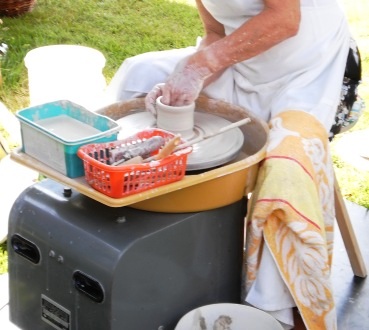 Throwing pots is possible for smaller pieces. Very large and heavy pieces are made with one of the previous techniques. They are crooked and torn apart by the centrifugal force of the rotation(al) movement. Beautiful pottery takes practice.
Throwing pots is possible for smaller pieces. Very large and heavy pieces are made with one of the previous techniques. They are crooked and torn apart by the centrifugal force of the rotation(al) movement. Beautiful pottery takes practice.
You paste a properly kneaded ball of clay on the center of the rotating wheel. With two hands you feel and bring it all the way into the center. You press with two thumbs the top of the bulb down. This provides a rough base form. With inside and outside pressing (always on both sides equally, and with wet hands), you make the desired shape. With a thin wire you can cut loose the shape of the rotating disk. After some drying, the piece can still be formed and processed: you can e.g. make a spout and ears.
To support large and broad scales you can wrap rope around them. Printings on excavated work prove that this technique is centuries old.
You can make a (ginger or garlic) grater by puncturing with a pointed blade a pattern in (part of) a freshly thrown bottom or a (small) bowl. Besides the hole a sharp edge of clay will come up by itself. Once baked and glazed it is a rasp. The Romans also made big scales in which soil they pressed small pebbles for this purpose.
An experienced driver in pot throwing in Ephesus at work. www.youtube.com/watch?v=hp2tplcNelU
